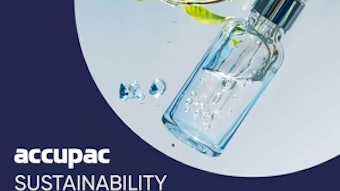
With sustainability now a baseline expectation for the consumer care industry,1 balancing responsibility and innovation in product development is critical for brands looking to enhance competitiveness, mitigate risk, and drive business growth. For formulators and product developers, this means navigating increasing pressure for transparency and environmental accountability, without compromising on performance.
The key to this?
Life Cycle Assessment
Life Cycle Assessment (LCA) analyses the inputs and outputs of a product system to evaluate the potential environmental impacts throughout its lifecycle; typically, from raw material extraction to product manufacture (Cradle-to-Gate) or all the way through to use and disposal (Cradle-to-Grave). For brands this means gaining visibility into environmental hotspots, allowing for targeted improvement, and making informed decisions early in the development process.
With 80% of a product’s environmental impact being influenced by decisions made at the design stage,2 LCA - particularly ingredient-level or predictive LCAs - can provide valuable data to guide formulators in selecting materials that align with sustainability goals and support claim substantiation.
But the benefits go beyond sustainability. LCA can also: support cost-saving initiatives by identifying inefficiencies; reveal emerging issues before they escalate; provide robust data for ESG reporting and regulatory readiness; and uncover supply chain insights.
An (In)Credible Method
At Croda Beauty, our LCA methodology follows the Environmental Footprint method, which was developed by the European Commission3 and is built on standards such as ISO 14000/44.
Croda Beauty is driving sustainable innovation in cosmetics ingredients, and LCA helps facilitate this. Our LCAs evaluate 16 key indicators including climate change, land use, water use, human toxicity, and eutrophication. This comprehensive approach gives brands the insights they need to understand any potential burden shifts, enabling them to best meet business needs.
Science-led Process
The LCA process involves stringent protocols and is comprised of four phases per ISO 14040:
Goal and scope definition: Considering the objective and intended audience, the analysis parameters such as the system boundary and functional unit (the quantifiable output for which the environmental impacts are being calculated) are defined.
Inventory analysis: Inputs and outputs within the system boundary – such as raw materials, energy, and waste – are collated and categorized. This requires precise knowledge of the production processes and lifecycle stages.
Impact assessment: Data is scaled to the requirements of the functional unit, which is then translated into quantified impacts using available primary or secondary data sources.
Interpretation: Following the above analysis, the quantified impacts can be interpreted and conclusions reported.
Within this structure, the parameters are flexible and user-inputted, allowing for tailored studies that generate comprehensive data reflecting the unique characteristics of each product or formulation.
Formulation in Focus – Comparative and Predictive LCAs
LCAs can be used to compare formulation options or predict impacts before development begins.
A comparative LCA utilizes a counterfactual scenario which, when graphically plotted, can help to visually identify and understand any burden shift associated with the tested differentials. Variables may include materials with similar functions but different environmental profiles, or process optimizations such as effluent waste versus incineration or the effects of increased atom economy (a measurement of the efficiency of chemical reactions).
Alternatively, a predictive LCA based on supplier data can help to compare ingredient inputs prior to formulating, such as if considering the substitution of petrochemical for bio-based feedstocks. An LCA in this scenario can demonstrate if, or across which environmental indicators, one may have an advantage over the other.
In the illustrative example shown below in Figure 1, each of the 16 impact factors are expressed as relative percentages, with the highest of the two values being displayed as 100%. In this theoretical case, Ingredient A has lower climate change and land use impacts, but at the cost of a much higher water use impact.
It is rare to find an ingredient that outperforms another in all categories, therefore LCA results should be considered with the product, industry, and key areas of concern or desired claims in mind.
Hotspot Analysis: Targeting What Matters
Another application of LCA data is hotspot analysis, which identifies the areas with the greatest environmental burden and can be illustrated graphically, as shown below in Figure 2.
The more accurate and granular the data, the more effectively brands can identify processes or ingredients in need of attention or, in the case of predictive LCAs for formulation, where alternative options may wish to be explored.
A cradle-to-grave LCA may also help quantify end-of-life advantages, such as multi-purpose or rinse-free formulas, or longer-lasting performance. This data may not only demonstrate reduced environmental impact but could also support consumer communications that resonate in a crowded market.
Limitations
LCA is a powerful tool, but not an exhaustive solution.
For example, LCAs do not assess social impacts, and comparisons are only valid when methodologies, boundaries, and reference data is consistent. Creating an LCA is also a data-heavy process, with data quality being critical – poor data can lead to misleading conclusions. That is why an LCA is best used alongside other tools, ensuring transparency in assumptions and sources.
Conclusions
LCA is more than a compliance tool – it’s a strategic asset. It empowers formulators and product developers to design with purpose, optimize with precision, and communicate with confidence.
At Croda Beauty, sustainability is at our core. We are investing in people, platforms, and partnerships to help our customers navigate complexity and unlock new value through sustainable innovation. We have ambitions to generate more LCA data for our customers to help them avoid the cost and complexity of conducting assessments from scratch.
Find out more about sustainability at Croda Beauty by visiting
www.crodabeauty.com/our-impact.
Sources:
- Mintel (2025) 2025 BPC Trend: Turning the Tide
- Ellen MacArthur Foundation (2022) An Introduction to Circular Design
- European Commission (2025) Environmental Footprint Methods
Disclaimer:
The above paid-for content was produced by and posted on behalf of the Sponsor. Content provided is generated solely by the Sponsor or its affiliates, and it is the Sponsor’s responsibility for the accuracy, completeness and validity of all information included. Global Cosmetic Industry takes steps to ensure that you will not confuse sponsored content with content produced by Global Cosmetic Industry and governed by its editorial policy.
Figure 1. Illustrative spider diagram comparing a test ingredient (A) and counterfactual ingredient (B)
 Figure 1. Illustrative spider diagram comparing a test ingredient (A) and counterfactual ingredient (B)Image courtesy of Croda Beauty
Figure 1. Illustrative spider diagram comparing a test ingredient (A) and counterfactual ingredient (B)Image courtesy of Croda Beauty
Figure 2. Illustrative hotspot indicator graph covering 10 of 16 impact categories
 Figure 2. Illustrative hotspot indicator graph covering 10 of 16 impact categoriesImage courtesy of Croda Beauty
Figure 2. Illustrative hotspot indicator graph covering 10 of 16 impact categoriesImage courtesy of Croda Beauty










